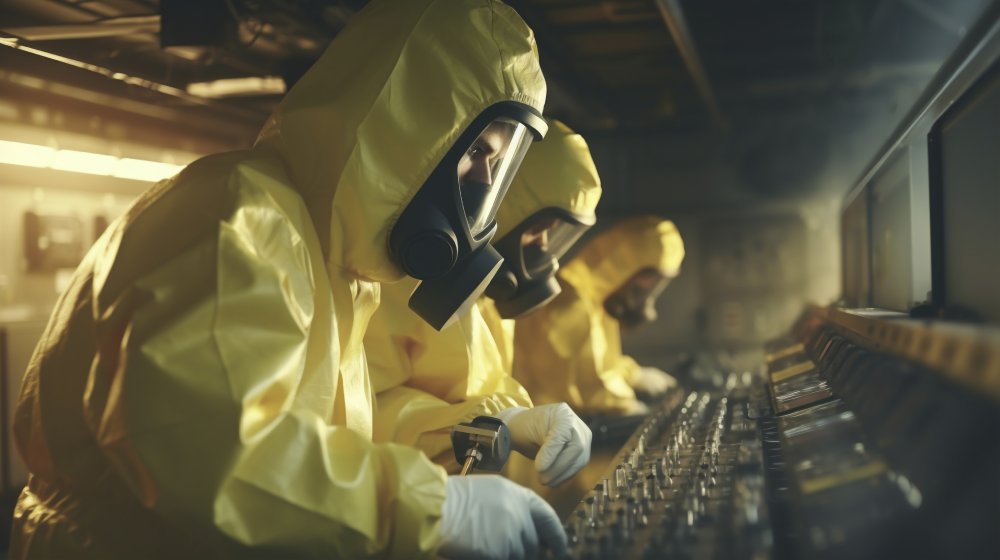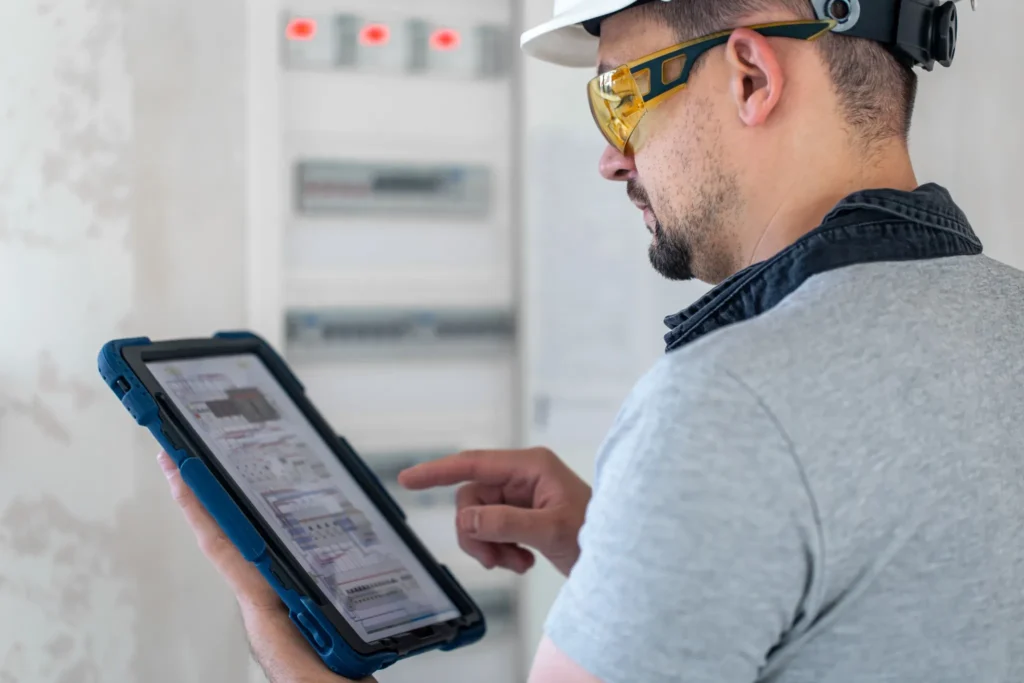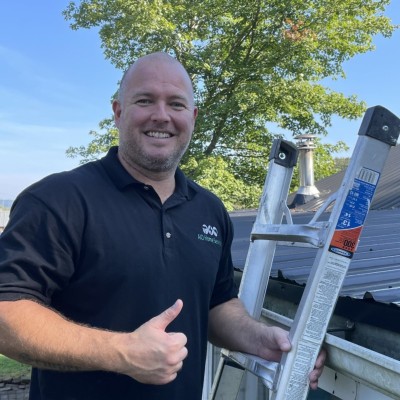Asbestos air sampling involves collecting samples from potentially contaminated spaces using specialized equipment such as air pumps and filters. These samples are then analyzed in a laboratory to detect the concentration of asbestos fibres in the air.
The results help determine whether the exposure levels are safe or whether further actions, such as abatement or preventive measures, are needed. Regular air sampling is often required during asbestos removal Ohio projects or when there is concern about existing asbestos in older buildings.
Asbestos Air Monitoring Equipment
Asbestos air monitoring equipment measures and detects asbestos fibres, typically during construction or demolition activities, renovation projects, or areas where asbestos-containing materials (ACMs) are present.
This equipment is crucial for ensuring the safety of workers and the general public by preventing exposure to harmful asbestos fibres, which can lead to serious health issues like mesothelioma, lung cancer, and asbestosis.
Here are some types of equipment used for asbestos air monitoring:
- Pump-Driven Air Samplers: These are used to collect air samples that can later be analyzed in a laboratory for asbestos fibres. The pump draws air through a filter, trapping any asbestos fibres.
- Real-Time Monitors: These more advanced instruments can provide immediate feedback on asbestos fibre concentration in the air. They use light scattering or laser technology to detect fibres in the air in real-time.
- Grab Samplers: These devices are used for short-term sampling, where a sample is taken over a brief period (e.g., 10 minutes to 1 hour) and then analyzed.
- Phase Contrast Microscopy (PCM) is a technique for counting airborne asbestos fibres. The air samples collected by samplers are analyzed under a microscope to detect asbestos fibres. This is a common method for air testing, though more advanced techniques like transmission electron microscopy (TEM) may be used for more precise results.
- Portable Air Sampling Pumps: These are lightweight and designed to be carried during fieldwork. They collect air samples over a set period to monitor asbestos exposure levels in real-time or for subsequent lab analysis.
Using these tools, professionals can assess the level of asbestos contamination in the air and take necessary actions to control exposure, such as sealing off affected areas or employing more stringent safety protocols. Regular monitoring is essential, particularly during the renovation or demolition of buildings with known asbestos materials.

Asbestos Air Sampling Procedure
Asbestos air sampling is a critical procedure used to determine the concentration of airborne asbestos fibres in an environment. The procedure is important to ensure that asbestos levels are within safe limits, especially during construction, demolition, or renovation work where asbestos-containing materials (ACMs) may be disturbed. Here’s an overview of the general procedure for asbestos air sampling:
1. Pre-Sampling Preparations:
- Assess the Area: Identify areas that are at risk of asbestos contamination. This might include locations where ACMs are present or areas disturbed by construction or renovation work.
- Determine Sampling Strategy: Decide the air samples needed and the sampling duration. Sampling locations should represent areas with potential asbestos exposure. Personal air sampling (on the worker) and area air sampling (in the surrounding environment) should be considered for accurate results.
- Prepare Safety Equipment: Ensure all personal protective equipment (PPE) is in place, such as respiratory protection (e.g., NIOSH-approved respirators), gloves, and protective clothing.
2. Setting Up the Air Sampler:
- Select the Equipment: Choose the appropriate sampling device (e.g., pump-driven samplers, real-time monitors, or grab samplers). The equipment should collect sufficient air volume at a constant flow rate (typically 0.1 to 1.5 litres per minute, depending on the sampling device).
- Calibrate the Equipment: Before beginning, calibrate the air sampling pump to ensure the correct flow rate is maintained throughout the sampling process. Calibration is typically done with a primary standard flow meter.
- Attach a Filter: The air sampler should have a filter to capture airborne fibres. Common filters include membrane filters (e.g., mixed cellulose ester or polycarbonate filters), which are small enough to trap asbestos fibres.
- Position the Sampler: Place the air sampler at the appropriate location. For personal sampling, the worker wears the sampler (usually near their breathing zone). The sampler is placed strategically throughout the affected area for area sampling.
3. Air Sampling Procedure:
- Start the Pump: Begin the sampling process by turning on the pump and ensuring it draws air at the desired flow rate. Allow the pump to run for the required duration (typically 4-8 hours for a standard full-shift sample).
- Monitor the Equipment: During the sampling, check the equipment periodically to ensure it’s functioning properly and maintaining the correct flow rate.
- End the Sampling: Once the required sampling time has been completed, turn off the pump and remove the filter. Properly seal the filter in a clean, labelled container to prevent contamination during transport.
4. Post-Sampling Procedures:
- Label the Samples: Each sample should be carefully labelled with relevant information such as the sampling location, date, time, and other pertinent details (e.g., worker ID, flow rate).
- Transport to Lab: The samples should be transported to a certified laboratory for analysis. Proper documentation should accompany the samples to ensure correct identification and handling.
5. Laboratory Analysis:
- Analysis Method: The collected filters are typically analyzed using Phase Contrast Microscopy (PCM) or Transmission Electron Microscopy (TEM) to count and identify the asbestos fibres. PCM is used for general air quality monitoring, while TEM is more sensitive and can identify specific types of asbestos fibres.
- Results Interpretation: The laboratory will report the concentration of asbestos fibres in the air, typically measured in fibres per cubic centimetre (f/cc). Further containment, remediation, or personal protective measures may be required if the results exceed regulatory limits.
6. Follow-Up Actions:
- Review Results: Once the results are available, compare them to regulatory limits (e.g., OSHA or EPA standards). If levels exceed the permissible exposure limits (PEL), appropriate steps must be taken, including:
- Sealing or removing the ACMs
- Enhancing ventilation
- Increasing PPE requirements for workers
- Take Corrective Measures: Depending on the results, additional sampling may be required, or the work site may need to be evacuated or decontaminated to prevent exposure.
Key Considerations:
- Flow Rate and Duration: Accurate flow rate calibration is essential to ensure that air sampling is done correctly. The sampling duration should be adequate to capture representative air quality.
- Environmental Conditions: The weather (wind, temperature, humidity) can affect the sampling, so these factors should be monitored and considered when interpreting results.
- Regulations and Standards: Follow local and international guidelines for asbestos sampling, such as those from the Occupational Safety and Health Administration (OSHA) or Environmental Protection Agency (EPA) in the United States or equivalent regulatory bodies in other countries.
Asbestos air sampling is vital to managing asbestos-related risks and ensuring the safety of workers and the public. Proper sampling, analysis, and response to findings help prevent exposure to harmful asbestos fibres.
Asbestos Air Monitoring Requirements

Asbestos air monitoring is critical to ensuring safe work environments and protecting workers from the harmful effects of asbestos exposure. The requirements for air monitoring depend on local regulations (such as OSHA in the U.S. or HSE in the UK), the type of asbestos work being conducted, and the risk level involved. Below are the key aspects of asbestos air monitoring requirements:
1. Regulatory Requirements:
Different agencies set specific exposure limits for airborne asbestos fibres and protocols for air monitoring during asbestos-related work.
- OSHA (Occupational Safety and Health Administration, U.S.):
- Permissible Exposure Limit (PEL): OSHA sets a PEL of 0.1 fibres per cubic centimetre (f/cc) for asbestos, averaged over an 8-hour workday.
- Excursion Limit: OSHA also has an excursion limit of 1.0 f/cc over 30 minutes, meaning air monitoring should detect spikes exceeding this concentration.
- Air Monitoring During Asbestos Removal: Air monitoring is required during asbestos removal or any disturbance of asbestos-containing materials (ACMs). This includes personal air sampling for workers and area air sampling for the surrounding environment.
- Clearance Air Sampling: After asbestos removal, air monitoring (clearance sampling) is required to confirm that the area is safe for re-entry. Typically, clearance levels must be below 0.01 f/cc (for PCM analysis).
- EPA (Environmental Protection Agency, U.S.):
- Asbestos Hazard Emergency Response Act (AHERA): The EPA requires air monitoring when performing asbestos abatement in schools or other public buildings. Under AHERA, monitoring must be conducted during abatement activities and may include personal and area monitoring.
- Air Sampling Standards: Depending on the required sensitivity, the EPA requires clearance testing using Phase Contrast Microscopy (PCM) or Transmission Electron Microscopy (TEM).
- HSE (Health and Safety Executive, UK):
- Control Limit: The UK HSE recommends a limit of 0.1 f/cc for asbestos exposure during the workday.
- Monitoring During Work: In high-risk activities like asbestos removal, continuous or regular air monitoring is required to ensure that the levels of asbestos fibres do not exceed the control limit.
- Post-Abatement Clearance: After asbestos removal, air samples must show that the fibre concentration has fallen below 0.01 f/cc (using PCM) for the area to be declared safe.
2. Personal and Area Air Monitoring:
- Personal Air Monitoring:
- Conducted on workers to assess individual exposure to airborne asbestos fibres.
- A pump draws air through a filter at a constant rate (typically 0.1–1.5 L/min) and traps asbestos fibres for later analysis.
- Personal air sampling must be done during the worker’s shift to capture a full exposure profile.
- Area Air Monitoring:
- Used to measure the general air quality in areas surrounding asbestos work zones.
- Sampling is conducted at strategic locations around the work site, typically near the perimeter, to assess the potential risk to the public and other workers.
- Area air sampling may be required for the duration of the job or intermittently during high-risk tasks.
3. Air Sampling and Analysis Methods:
The type of air sampling method and analysis determines whether the asbestos fibres in the air are being accurately quantified.
- Phase Contrast Microscopy (PCM):
- Commonly used for bulk asbestos monitoring and routine air sampling during asbestos removal or renovation activities.
- Limitations: PCM can only count asbestos fibres that are >5 µm long, meaning very small fibres may not be counted.
- Use: Typically used to check compliance with OSHA’s exposure limits. A concentration of 0.1 f/cc is considered the permissible exposure limit.
- Transmission Electron Microscopy (TEM):
- TEM offers a more detailed and precise analysis, detecting all fibre types and sizes, including shorter and less detectable types like amphibole asbestos.
- TEM is typically used for clearance air sampling (post-abatement) and in cases requiring higher sensitivity (e.g., compliance with lower limits, such as 0.01 f/cc).
4. Sampling Frequency:
- During Abatement Activities: Sampling frequency depends on the type of work being done. Continuous monitoring may be required in high-risk situations, such as asbestos removal or after-work stoppages.
- Clearance Testing: After asbestos removal or disturbance is completed, clearance testing (air sampling) is required to ensure the air is safe for re-entry or public access. This typically involves post-abatement testing to confirm that airborne fibre levels are below the acceptable limits (0.01 f/cc or less).
5. Clearance Testing (Post-Removal):
- After asbestos removal or disturbance, air monitoring must confirm that the area is safe for re-entry or public access. The goal is to demonstrate that the fibre concentration is below the regulatory threshold.
- Air Sampling Method: Post-abatement air sampling often uses PCM or TEM, depending on local requirements and the level of sensitivity needed.
- Results: If the fibre concentration is below 0.01 f/cc, the area can be deemed free of asbestos hazards.
6. Reporting and Record-Keeping:
- Documentation: All air monitoring results, including sample locations, flow rates, and fibre concentrations, must be documented and kept for compliance purposes.
- Laboratory Reports: The analysis results should be submitted by a certified laboratory, with clear reports outlining the concentration of asbestos fibres, the methodology used, and whether the results comply with the applicable standards.
- Health and Safety Reporting: If air monitoring detects asbestos fibre concentrations exceeding the permissible limits, the findings must be reported to the relevant authorities, and corrective actions must be taken immediately.
7. Maintenance of Equipment:
- Ensure air sampling equipment (pumps, filters, and analytical devices) is regularly maintained and calibrated to ensure accurate results.
- Regular checks should be done to ensure filters are correctly sealed and sampling pumps are working at the designated flow rates.
8. Worker Protection:
- PPE (Personal Protective Equipment): During air sampling, workers should wear appropriate PPE, including respirators (such as P100 or HEPA filters), disposable coveralls, gloves, and goggles, to avoid exposure to asbestos fibres.
- Training: All workers involved in asbestos monitoring and sampling must receive specialized training to handle equipment and interpret results safely and accurately.
Air Monitoring Device for Asbestos

Air monitoring devices for asbestos are specialized instruments designed to detect and measure airborne asbestos fibres in environments where asbestos-containing materials (ACMs) are present or disturbed.
These devices are essential for ensuring that asbestos exposure levels do not exceed safe limits, protecting workers and the public from the harmful effects of asbestos inhalation.
Here’s an overview of common air monitoring devices for asbestos:
1. Pump-Driven Air Samplers:
- Function: These devices collect air samples by drawing air through a filter at a specific flow rate, which traps asbestos fibres. The filter is then analyzed in a laboratory to determine the concentration of asbestos in the air.
- Examples:
- SKC Air Sampling Pumps
- 3M Personal Air Sampling Pump
- Application: These are typically used for personal air monitoring (for workers) and area air monitoring (in surrounding environments). They can sample for extended periods (usually 4–8 hours) to capture a full work shift’s worth of exposure.
- Features:
- Adjustable flow rate (typically 0.1 to 1.5 L/min)
- Compatible with different filter types (e.g., mixed cellulose ester filters, polycarbonate filters)
2. Real-Time Asbestos Monitors:
- Function: These devices provide continuous real-time measurement of asbestos fibres in the air. They do not require sending samples to a laboratory for analysis, providing immediate feedback on the air quality.
- Technology Used: These real-time monitors typically use light scattering or laser-based techniques to detect asbestos fibres in the air.
- Examples:
- TSI AeroTrak™ (TSI offers a range of real-time monitors that can detect airborne particles, including asbestos)
- SpectroSpheres™ Real-Time Airborne Particle Analyzer
- Application: This is ideal for situations where ongoing monitoring is necessary, such as during active asbestos removal, demolition, or construction work.
- Features:
- Provides immediate readout of asbestos fiber concentration
- Can set threshold limits for automatic alarms if fibre levels exceed safe limits
- Capable of measuring fibre size distribution
3. High-Volume Air Samplers:
- Function: High-volume air samplers collect larger volumes of air over extended periods, typically 12 to 24 hours, to measure low concentrations of asbestos in ambient air. These devices are often used for environmental monitoring in areas where asbestos has been disturbed but are not the focus of immediate abatement work.
- Examples:
- Grimm 1.108 High Volume Sampler
- AirTec® High-Volume Air Sampler
- Application: These devices monitor asbestos in the environment, particularly in areas outside the work zone, to assess its impact on public health.
- Features:
- High flow rates for large air volume collection
- It can be used with various filter types for analysis.
4. Phase Contrast Microscopy (PCM) Filters:
- Function: Although not a standalone air monitoring device, PCM filters are commonly combined with air samplers to capture airborne asbestos fibres. PCM is the most widely used method for counting asbestos fibres, particularly in compliance with OSHA and EPA regulations.
- Examples:
- MCE (Mixed Cellulose Ester) Membrane Filters
- Polycarbonate Filters
- Application: These filters are often used in personal and area air samplers to collect samples for laboratory analysis via PCM.
- Features:
- Capture fibres for microscopic examination.
- Transparent for easy fibre counting under a microscope
5. Transmission Electron Microscopy (TEM) Air Sampling:
- Function: TEM is a highly sensitive technique for detecting and identifying asbestos fibres, especially those smaller than the detection limit of PCM. It’s commonly used for clearance testing (post-abatement) and when higher sensitivity is required.
- Examples:
- JEOL JEM Series Electron Microscopes
- Application: TEM analysis is essential when asbestos levels are very low or specific fibre types (such as amphibole) must be identified. TEM is more expensive and labour-intensive than PCM but provides highly detailed results.
- Features:
- Extremely high-resolution analysis
- Can detect all types of asbestos fibres, including very fine ones
6. Portable Asbestos Sampling Pumps:
- Function: These lightweight, portable devices collect air samples from specific areas, often for personal air monitoring or short-term sampling (e.g., during particular tasks like asbestos cutting or removal).
- Examples:
- Casella Microflow Pumps
- SKC AirChek® 2000
- Application: These are ideal for personal monitoring when workers need to be monitored for exposure throughout the workday. They can also be used for area sampling during specific activities, like demolition or maintenance.
- Features:
- Battery-powered for portability
- Compact and easy to wear or position in the field
7. Grab Sampling Devices:
- Function: Grab sampling devices collect air samples for a short period, typically between 10 minutes and 1 hour, to monitor airborne asbestos during specific activities or high-risk tasks.
- Examples:
- SKC AirCheck™ 2000
- Gastec® or Dräger sampling tubes (for short-term sampling)
- Application: Grab samplers are used when immediate, quick measurements are needed, such as during spot checks or assessment of airborne asbestos during a specific event.
- Features:
- Quick, easy to deploy for short-term sampling
- It can be used for quick assessment in high-risk zones.
If you think that you May Need Test so you can book asbestos Testing Removal Now and if you want to Know How Asbestos Look Like Follow this Guide
FAQs
Can you see or smell asbestos fibres in the air?
Asbestos fibres are microscopic and cannot be seen or smelled in the air.
How to test air quality for asbestos?
Air quality for asbestos is tested by collecting air samples using air pumps, filters, and specialized analysis methods like Phase Contrast Microscopy (PCM) or Transmission Electron Microscopy (TEM) to detect asbestos fibres.
What is an asbestos air test?
An asbestos air test involves sampling air to detect the presence of asbestos fibres. Typically, a pump draws air through a filter, which is then analyzed in a lab to measure the fibre concentration.
When is asbestos air monitoring required?
Asbestos air monitoring is required during activities that disturb asbestos-containing materials (ACMs), such as removal, renovation, demolition, or maintenance. Post-abatement clearance testing is also needed to ensure asbestos levels are safe for reoccupation.

